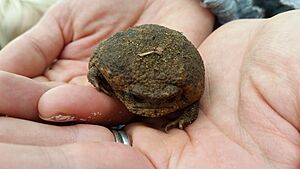Cape rain frog facts for kids
Quick facts for kids Cape rain frog |
|
|---|---|
 |
|
| Conservation status | |
| Scientific classification |
The Cape rain frog or giant rain frog (Breviceps gibbosus) is a special type of frog found only in South Africa. These frogs are quite small, growing up to about 4.5 centimeters (or 2 inches) long. They were the first African frog species ever described by scientists, way back in 1758 by Carl Linnaeus. The Cape rain frog is the biggest and most common of all the rain frogs. They get their name "rain frog" because people used to believe these frogs could bring rain!
Contents
Where They Live

These unique frogs live only in the far southwestern part of South Africa. You can find them around Cape Town and stretching north towards Citrusdal. They make their homes in areas with Mediterranean-style plants, like the fynbos and renosterveld shrublands. They also live in farm fields, gardens in the countryside, and even in urban areas. Cape rain frogs can adapt pretty well to living in suburban gardens. However, they can be harmed by garden chemicals like herbicides and might be in danger from pets.
What They Look Like and Sound Like
The Cape rain frog has a very round body and short, stubby arms. Female frogs are usually bigger than the males. Their legs are shorter than their bodies, which makes them look quite plump! They have brown skin with white dots on their bellies. Their eyes face forward, and they don't have webbing between their toes. These frogs are also sometimes called narrow-mouth toads because they have a small mouth and a narrow head.
Cape rain frogs make a very unique sound. During mating season, the male frogs burrow underground and make a series of short, squawking noises to call the females.
How They Stick Together
When Cape rain frogs mate, they have a special way of sticking to each other. Both male and female frogs have special glands that make a sticky, glue-like substance. These glands are on the chest area of the males and on the back of the females. This sticky "glue" helps the mating pair stay attached during reproduction, which is especially important because the male is too small to hold onto the female tightly.
Life Underground
The Cape rain frog spends most of its life underground. It usually comes out just before it rains, which is how it got its common name. You might also spot them when it's misty or damp outside. When these frogs burrow, they help to loosen and aerate the soil in the southwestern Cape. They mostly eat worms and small insects.
If a Cape rain frog feels scared, it can swallow air to make itself look bigger and scarier to predators. This is why they are sometimes called blaasoppie in Afrikaans, which means "little puffer." Because they are burrowing frogs, they have strong, muscular legs that help them dig their shelters. These frogs cannot swim and will actually drown if they are put in water.
Breeding Habits
During the mating season, male Cape rain frogs call out from under plants or from inside their burrows. This helps the females find them. Since the male is too small to get a good grip on the female, she produces a sticky liquid. This liquid acts like glue, sticking him to her back!
The female then digs a burrow where she lays groups of about 22 eggs. Along with fertile eggs, she also lays jelly-like capsules. These capsules help keep the developing froglets moist. The female frog stays hidden near her eggs underground until they hatch into tiny froglets. Unlike many other frogs, Cape rain frogs do not have a tadpole stage; they hatch directly into miniature frogs!
Protecting the Cape Rain Frog
The Cape rain frog is currently classified as a near-threatened species by the IUCN. This means they could become endangered in the future if we don't protect them. The biggest problem they face is the loss of their natural home, the fynbos areas. This happens because cities are growing and more land is being used for farming.
Their habitat is being destroyed and broken up into smaller pieces, which makes it harder for the frogs to survive. While there aren't many specific projects just for them, some populations of these frogs live in protected areas. These include the Cape Peninsula National Park, Helderberg Nature Reserve, and Paarl Mountain Nature Reserve. In residential areas, people can help by not paving over their gardens and by keeping open spaces natural instead of building on them.
What They Eat
The Cape rain frog's diet mainly includes worms, termites, and other small insects.
How They Survive
Like other frogs in its family, the Cape rain frog has a unique body shape that stops it from jumping or swimming. So, it has special ways to stay safe. When it feels threatened, it can inflate its body with air to look bigger and scare away predators. It can also make a high-pitched chirping sound when it's in danger. If possible, it will also retreat into its burrow to hide from anything that might harm it.


